Design Optimization of a Hydrodynamic Brake with an Electrorheological Fluid
Abstract
:1. Introduction
2. Construction of the Hydrodynamic Brake
3. The Mathematical Model of the Hydrodynamic Brake
3.1. The Mathematical Model of the Hydrodynamic Brake Geometry
3.2. Mathematical Model of Hydraulic Interactions
3.3. Mathematical Model of the Electric Circuit of the Hydrodynamic Brake
3.4. Coefficient Selection for the Mathematical Model of the Hydrodynamic Brake
4. Optimization Method for the Hydrodynamic Brake Design
4.1. Selection of Design Variables
4.2. Selection of Optimization Criteria
- it is assumed that ω1 = 200 rad/s;
- the radii rw and R are randomly selected from the intervals given in Table 3;
- it is assumed that gb = 0.02 R;
- calculations are performed according to the formulas of the mathematical model described in Section 2;
- the calculation results not meeting the requirements given in Table 3 are rejected.
4.3. The Algorithm for Design Optimization of the Hydrodynamic Brake
- the decision variables rw, R, and n are randomly selected from the assumed intervals with the use of a random number generator;
- the value of ω1 is determined and gb = 0.02R is calculated;
- calculations are performed according to the formulas of the mathematical model;
- the constraints of d1 and Uh are checked;
- when the randomly selected values of the design variables meet the conditions of the constraints, the objective function F is calculated, its result is saved, and the calculations are repeated;
- the smaller value of the objective function from the previous Fp and present step of the calculations Fa is selected;
- the values of the design variables rw, R, and n are saved, and on the basis of these values, an objective function of a smaller value is obtained.
5. Design Optimization Results and Discussion
6. Conclusions
- Performing the optimization of the HB with the ER fluid requires formulating a mathematical model, establishing constraints, and selecting design variables and the objective function. While planning the design optimization, it is advisable to aim at a simple mathematical model and a low number of design variables, especially when the optimization calculations are performed with the use of the Monte Carlo method (so that it is possible to perform a large number of calculations within an acceptable time). On the basis of the obtained results of the optimization of the HB with the ER fluid, it can be presumed that the assumptions are correct.
- The form of the objective function has a significant influence on the optimization results. However, there are no strict rules as to how the objective function should be formulated. This is why the selection of the objective function is always arbitrary. It is advisable to formulate the objective function in a simple way, so that the results of optimization calculations are easy to interpret. Defining two different objective functions on the basis of the same criteria increases the probability of finding the optimal solution. Due to that, it is justifiable to use the difference and quotient of only two criteria when optimizing the design of the HB with the ER fluid in order to determine the objective function.
- The Monte Carlo method can be successfully used for design optimization of brakes with ER fluid for three design variables. Increasing the number of the design variables causes an exponential increase in the number of draws necessary to obtain the required accuracy of calculations. Not all optimization methods can be used for this purpose because the number of blades, which is a natural number, causes the calculations to be discrete.
- In order to obtain credible and reliable results of the optimization calculations, it is advisable to select coefficients for the assumed mathematical model, as well as for the range of the mathematical model. It is especially important when the HB optimization calculations are performed with the use of a mean streamline model whose accuracy depends on the correctness of the selected coefficients.
Author Contributions
Funding
Institutional Review Board Statement
Informed Consent Statement
Data Availability Statement
Conflicts of Interest
References
- Brun, K.; Meyenberg, C.; Thorp, J. Hydrodynamic torque converters for oil & gas compression and pumping applications: Basic principles, performance characteristics and applications. In Proceedings of the Asia & Pump Symposium Marina Bay Sand, Singapore, 22–25 February 2016; pp. 1–15. [Google Scholar] [CrossRef]
- Kęsy, Z.; Kęsy, A. Prospects for the control of a torque converter using magnetic fluid. In Proceedings of the IEEE International Colloquium on Innovative Actuators for Mechatronic Systems, London, UK, 18 October 1995; pp. 10-1–10-3. [Google Scholar]
- Dong, Y.Z.; Seo, Y.; Choi, H.J. Recent development of electro-responsive smart electrorheological fluids. Soft Matter 2019, 15, 3473–3486. [Google Scholar] [CrossRef]
- Qader, I.N.; Kök, M.; Dagdelen, F.; Aydogdu, Y.A. Review of smart materials: Researches and applications. El-Cezeri Fen Ve Mühendislik Derg. 2019, 6, 755–788. [Google Scholar] [CrossRef]
- Bulough, W.; Johnson, A.R.; Tozer, R.; Makin, J. Electrorheological clutch, methodology, performance and problems in ERclutch based positioning mechanisms. Intern. J. Mod. Phys. B13 1999, 14, 2101–2108. [Google Scholar] [CrossRef]
- Li, W.H.; Du, H. Design and experimental evaluation of a magnetorheological brake. Int. J. Adv. Manuf. Technol. 2003, 21, 508–515. [Google Scholar] [CrossRef]
- Choi, S.B.; Cheong, C.C.; Kim, G.W. Feedback control of tension in moving tape using an ER brake actuator. Mechatronics 1997, 7, 53–66. [Google Scholar] [CrossRef]
- Wereley, N.M.; Lindler, J.; Rosenfeld, N.; Choi, Y.T. Biviscous damping behavior in electrorheological shock absorbers. Smart Mater. Struc. 2004, 13, 743–752. [Google Scholar] [CrossRef]
- Choi, S.B. Performance comparison of vehicle suspensions featuring two different electrorheological shock absorbers. Proc. Inst. Mech. Eng. Part D J. Automob. Eng. 2003, 217, 999–1010. [Google Scholar] [CrossRef]
- Gołdasz, J.; Sapiński, B. Insight into Magnetorheological Shock Absorbers; Springer International Publishing: Cham, Switzerland, 2003. [Google Scholar] [CrossRef]
- Rosenfeld, N.C.; Wereley, N.M. Volume-constrained optimization of magnetorheological and electrorheological valves and dampers. Smart Mater. Struc. 2004, 13, 1303–1313. [Google Scholar] [CrossRef]
- Choi, S.B.; Choi, W.Y. Position control of a cylinder using a hydraulic bridge circuit with ER valves. J. Dyn. Syst. Meas. Control 2003, 122, 201–209. [Google Scholar] [CrossRef]
- Kciuk, S.; Martynowicz, P. Special application magnetorheological valve numerical and experimental. Solid State Phenom. 2011, 177, 102–115. [Google Scholar] [CrossRef]
- Szczęch, M. Theoretical analysis and experimental studies on torque friction in magnetic fluid seals. Proc. Inst. Mech. Eng. Part J J. Eng. Tribol. 2020, 234, 274–281. [Google Scholar] [CrossRef]
- Lara-Prieto, V.; Parkin, R.; Jackson, M.; Silberschmidt, V.; Kęsy, Z. Vibration characteristics of MR cantilevers and sandwich beams: Experimental study. Smart Mater. Struc. 2003, 19, 015005. [Google Scholar] [CrossRef] [Green Version]
- Berg, C.D.; Evans, L.F.; Kermode, P.R. Composite structure analysis of a hollow cantilever beam filled with electro–rheological fluid. J. Intell. Mater. Struct. 1996, 7, 494–502. [Google Scholar] [CrossRef]
- Choi, Y.T.; Wereley, N.M. Vibration control of a landing gear system featuring electrorheological/magnetorheological fluids. J. Aircr. 2003, 40, 432–439. [Google Scholar] [CrossRef]
- Mikułowski, G.; Holnicki-Szulc, J. Adaptive landing gear concept—Feedback control validation. Smart Mater. Struc. 2007, 16, 2146–2158. [Google Scholar] [CrossRef]
- Białek, M.; Jędryczka, C.; Milecki, A. Investigation of thermoplastic polyurethane finger cushion with magnetorheological fluid for soft-rigid gripper. Energies 2021, 14, 6541. [Google Scholar] [CrossRef]
- Fernández, M.A.; Chang, J.Y. Development of magnetorheological fluid clutch for robotic arm applications. In Proceedings of the 2016 IEEE 14th International Workshop on Advanced Motion Control (AMC), Auckland, New Zealand, 22–24 April 2016. [Google Scholar] [CrossRef]
- Rdice, I.; Bergmann, J.H. Conceptual exploration of a gravity-assisted electrorheological fluid-based gripping methodology for assistive technology. Bio-Des. Manuf. 2019, 2, 145–152. [Google Scholar] [CrossRef]
- Madeja, J.; Kęsy, Z.; Kęsy, A. Application of electrorheological fluid in a hydrodynamic clutch. Smart Mater. Struc. 2011, 20, 105005. [Google Scholar] [CrossRef]
- Olszak, A.; Osowski, K.; Kęsy, A.; Kęsy, Z. Experimental researches of hydraulic clutches with smart fluids. Int. Revive Mech. Eng. 2016, 10, 364–372. [Google Scholar] [CrossRef]
- Olszak, A.; Osowski, K.; Kęsy, Z.; Kęsy, A. Investigation of hydrodynamic clutch with MR fluid. J. Intell. Mater. Struct. 2018, 30, 155–168. [Google Scholar] [CrossRef]
- Musiałek, I.; Migus, M.; Osowski, K.; Olszak, A.; Kęsy, Z.; Kęsy, A.; Kim, G.W.; Choi, S.B. Analysis of a combined clutch with an electrorheological fluid. Smart Mater. Struc. 2020, 29, 087006. [Google Scholar] [CrossRef]
- Casella, G.; Robert, C.P. Monte Carlo Statistical Methods; LLC PubSpringer: New York, NY, USA, 2004. [Google Scholar]
- Kęsy, A.; Kęsy, Z.; Kądziela, A. Estimation of parameters for a hydrodynamic transmission system mathematical model with the application of genetic algorithm. In Evolutionary Methods in Mechanics; Kluwer Academic Press: Amsterdam, The Netherlands, 2004. [Google Scholar]
- Lempa, P.; Lisowski, E. Genetic algorithm in optimization of cycloid pump. Technol. Trans. Mech. 2013, 110, 229–236. [Google Scholar]
- Andersson, S. Analysis of multi-element torque converter transmissions. Int. J. Mech. Sci. 1986, 28, 431–441. [Google Scholar] [CrossRef]
- Asl, H.A.; Azad, N.L.; McPhee, J. Math-based torque converter modelling to evaluate damping characteristics and reverse flow mode operation. Int. J. Veh. Syst. Model. Test. 2014, 9, 36–55. [Google Scholar] [CrossRef]
- Behreus, H.; Jaschke, P.; Steinhausen, J.; Waller, H. Modeling of technical systems: Application to hydrodynamic torque converters and couplings. Math. Comput. Model. Dyn. Syst. 2000, 6, 223–250. [Google Scholar] [CrossRef]
- Jandasek, V.J. Design of single-stage, three element torque converter. Des. Pract. Passeng. Cars Autom. Transm. SAE 1970, 5, 201–226. [Google Scholar]
- Kęsy, A. Mathematical model of hydrodynamic torque converter for vehicle power transmission system optimization. Int. J. Veh. Des. 2012, 59, 1–22. [Google Scholar] [CrossRef]
- Nguyen, Q.H.; Lang, V.T.; Choi, S.B. Optimal design and selection of magneto-rheological brake types based on braking torque and mass. Smart Mater Struct. 2015, 24, 067001. [Google Scholar] [CrossRef]
- Nguyen, Q.H.; Lang, V.T.; Nguyen, N.D.; Choi, S.B. Geometric optimal design of a magneto-rheological brake considering different shapes for the brake envelope. Smart Mater. Struc. 2013, 23, 015020. [Google Scholar] [CrossRef]
- Żurowski, W.; Osowski, K.; Mędrek, G.; Musiałek, I.; Kęsy, A.; Kęsy, Z.; Choi, S.B. Design optimization of a viscous clutch with an electrorheological fluid. Smart Mater. Struc. 2022, 31, 095035. [Google Scholar] [CrossRef]
- Sohn, J.W.; Jeon, J.; Nguyen, Q.H.; Choi, S.B. Optimal design of disc-type magnetorheological brake for midsized motorcycle: Experimental evaluation. Smart Mater. Struct. 2015, 24, 085009. [Google Scholar] [CrossRef]
- Quoc, N.V.; Tuan, L.D.; Hiep, L.D.; Quoc, H.N.; Choi, S.B. Material characterization of MRF fluid on performance of MRF based brake. Front. Mater. 2019, 6, 125. [Google Scholar] [CrossRef]
- Erol, O.; Gurocak, H. Interactive design optimization of magnetorheological-brake actuators using the Taguchi method. Smart Mater. Struc. 2011, 20, 105027. [Google Scholar] [CrossRef]
- Gurubasavaraju, T.M.; Kumar, H.; Arun, M. Evaluation of optimal parameters o fMR fluids for damper application using particle swarm and response surface optimization. J. Braz. Soc. Mech. Sci. Eng. 2017, 39, 3683–3694. [Google Scholar] [CrossRef]
- Kęsy, Z. Numerical analysis of torque carried by vehicle hydrodynamic clutch with electrorheological working fluid. Int. J. Veh. Des. 2005, 38, 210–221. [Google Scholar] [CrossRef]
- Olszak, A.; Osowski, K.; Kęsy, Z.; Kęsy, A. Modelling and testing of a hydrodynamic clutch filled with electrorheological fluid in varying degree. J. Intell. Mater. Struct. 2019, 30, 649–660. [Google Scholar] [CrossRef]
- Wolff-Jesse, C.; Fees, G. Examination of flow behavior of electrorheological fluids in the flow mode. Proc. Inst. Mech. Eng. Part I J. Syst. Control Eng. 1998, 212, 159–173. [Google Scholar] [CrossRef]
- Nguyen, Q.A.; Jorgensen, S.J.; Ho, J.; Sentis, L. Characterization and testing of an electrorheological fluid valve for control of ERF actuators. Actuators 2015, 4, 135–155. [Google Scholar] [CrossRef] [Green Version]
- Kęsy, Z.; Mędrek, G.; Olszak, A.; Osowski, K.; Kęsy, A. Electrorheological fluid based clutches and brakes. In Reference Module in Materials Science and Materials Engineering; Elsevier: Amsterdam, The Netherlands, 2019. [Google Scholar] [CrossRef]
- SmartTechnologyLtd. UK. Information Brochure. 2004. Available online: www.smarttec.co.uk (accessed on 1 November 2022).
- Kęsy, Z.; Mędrek, G.; Osowski, K.; Olszak, A.; Migus, M.; Musiałek, I.; Musiałek, K.; Kęsy, A. Characteristics of electrorheological fluids. In Encyclopedia of Smart Materials; Elsevier: Amsterdam, The Netherlands, 2020. [Google Scholar] [CrossRef]
- Sturk, M.; Wu, X.M.; Wong, J.Y. Development and evaluation of a high voltage supply unit for electrorheological fluid dampers. Veh. Syst. Dyn. 1995, 24, 101–121. [Google Scholar] [CrossRef]
- Karakoc, K.; Park, E.J.; Suleman, A. Design considerations for an automotive magnetorheological brake. Mechatronics 2008, 18, 434–447. [Google Scholar] [CrossRef]
- Park, E.J.; Falcao DaLuz, L.; Suleman, A. Multidisciplinary design optimization of an automotive magnetorheological brake design. Comput. Struct. 2008, 86, 207–216. [Google Scholar] [CrossRef]

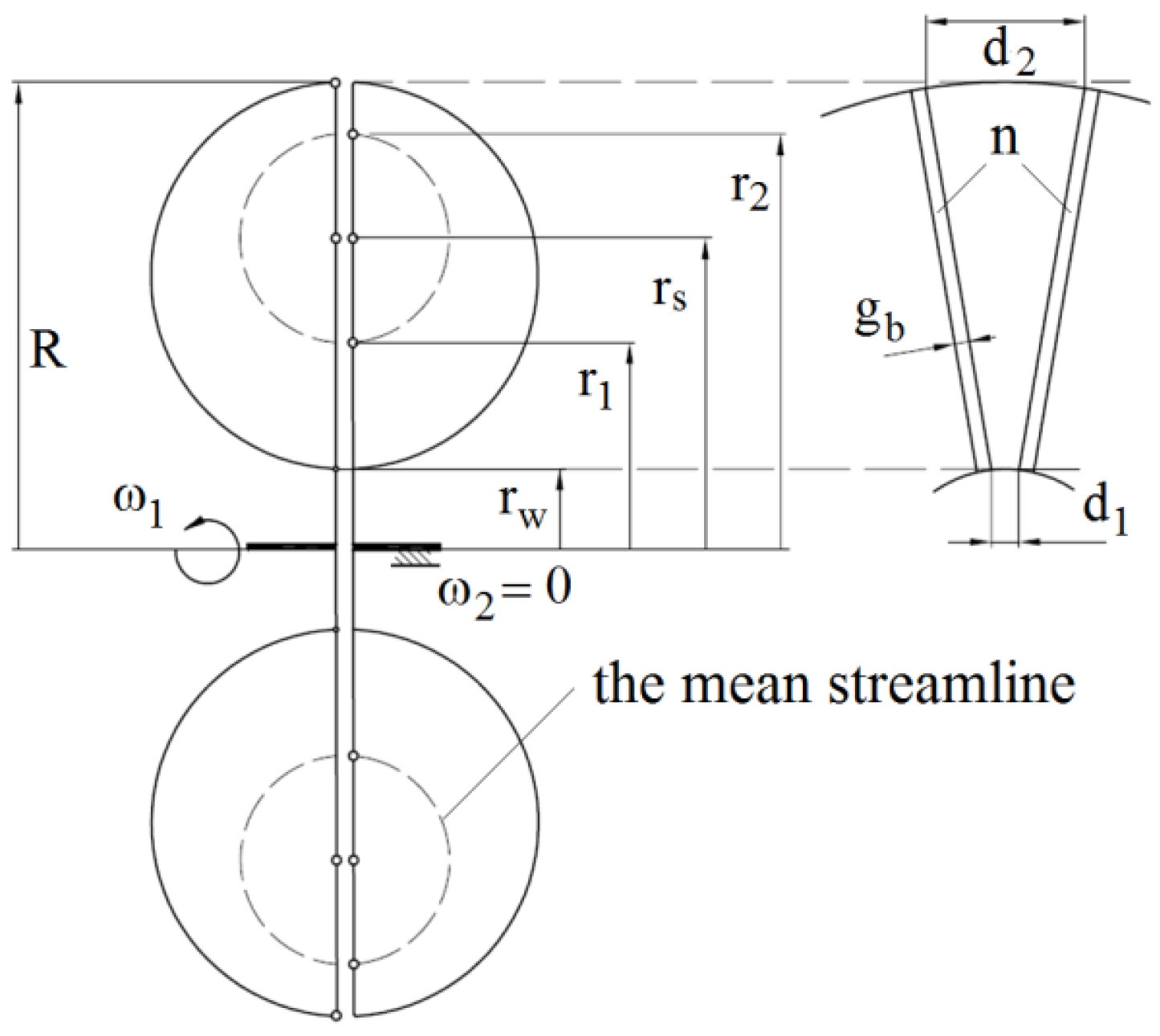
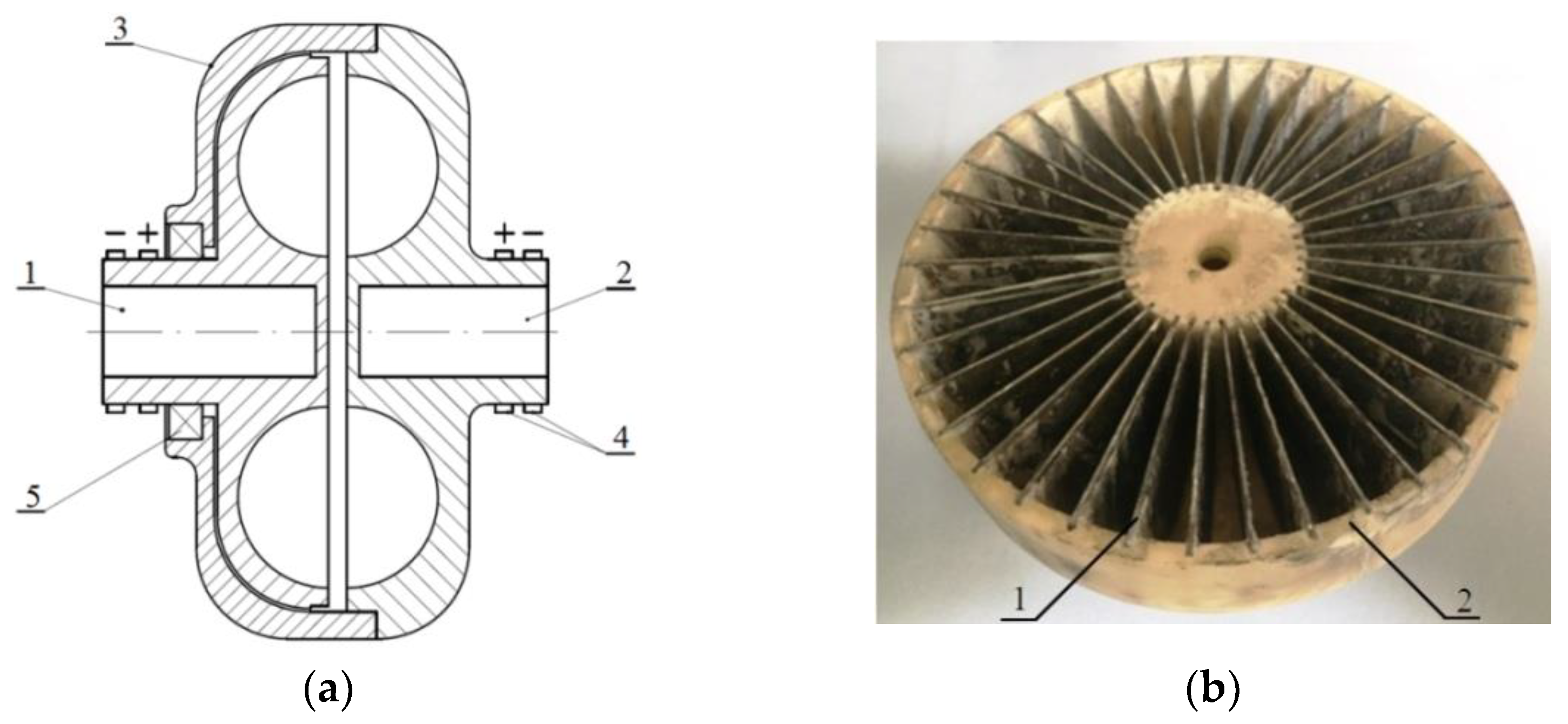
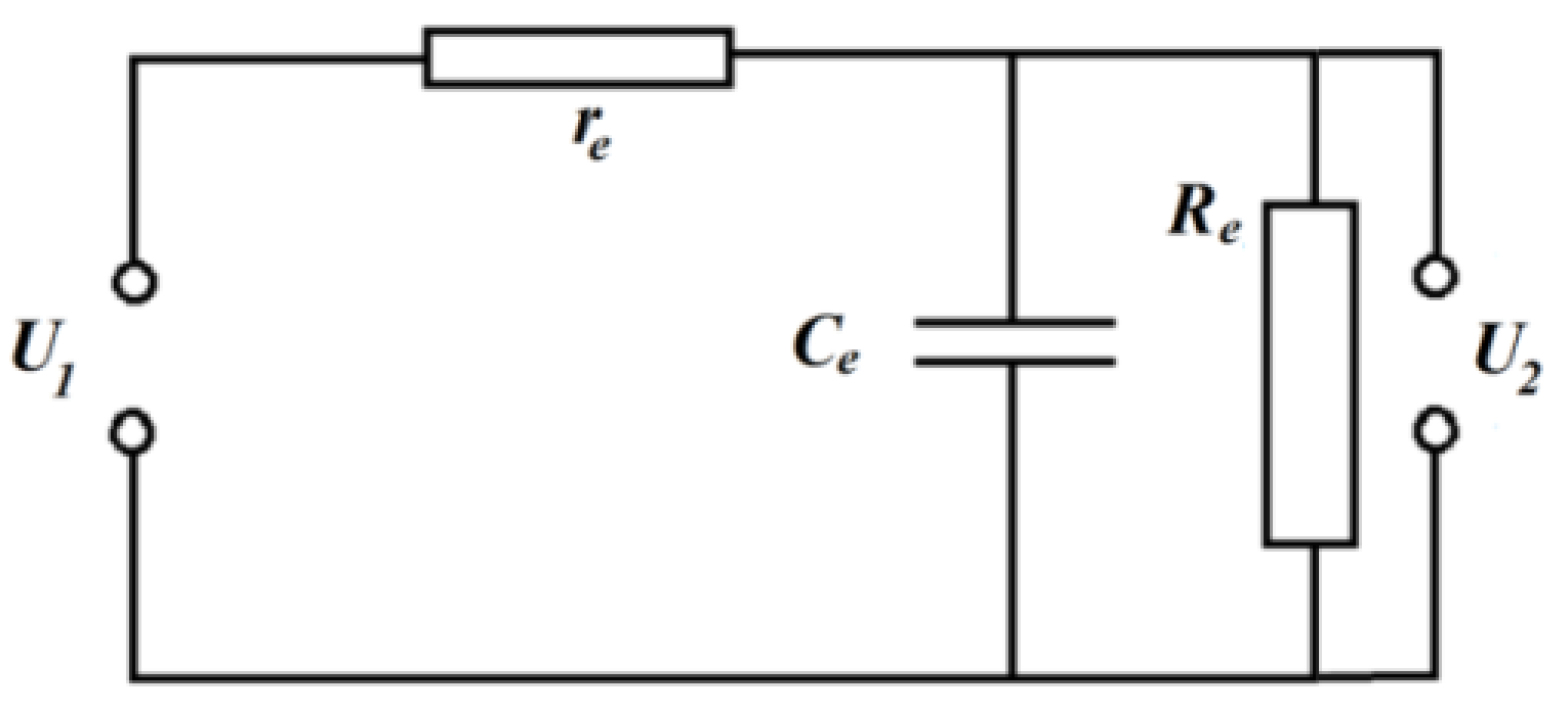
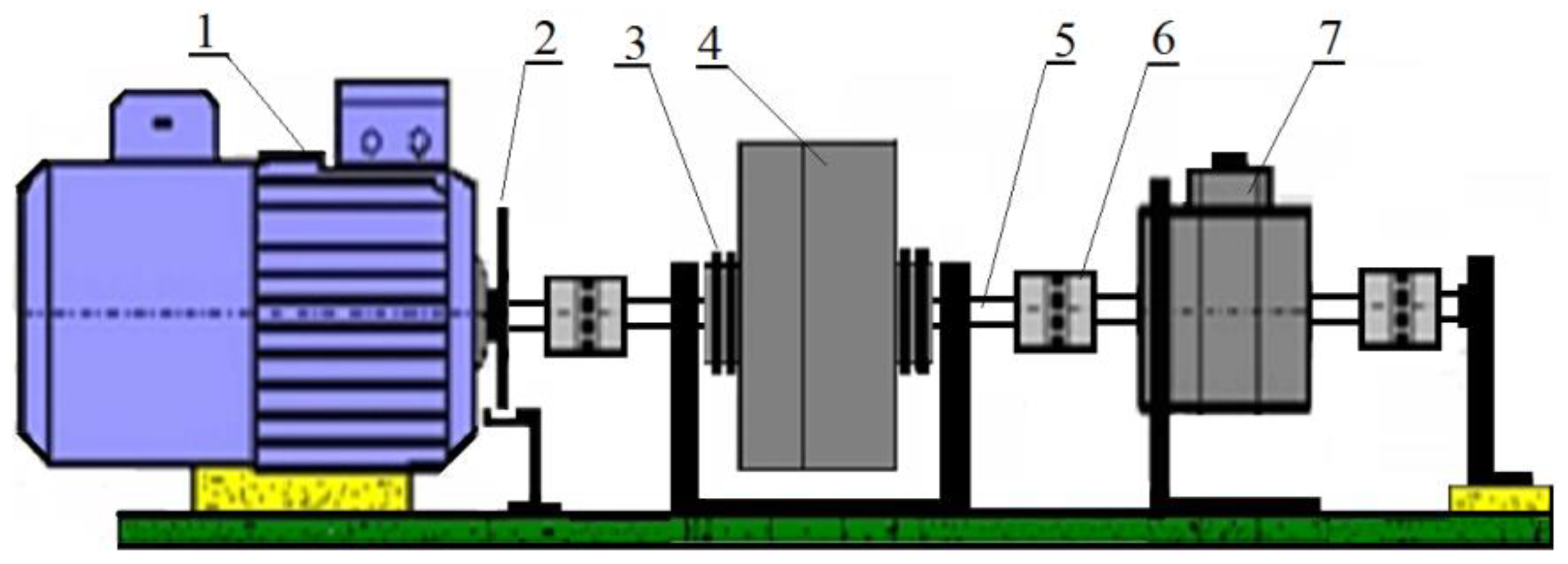
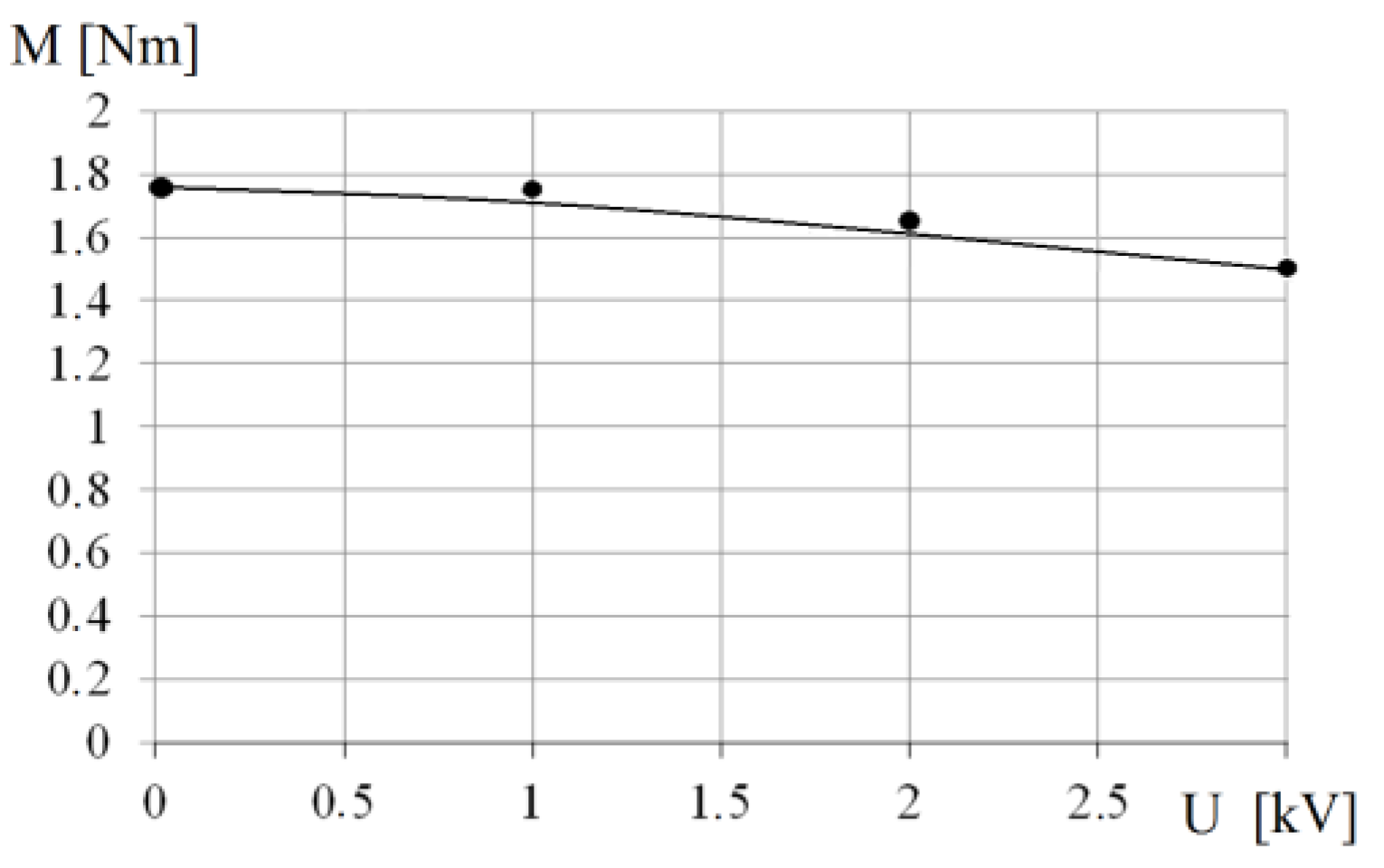
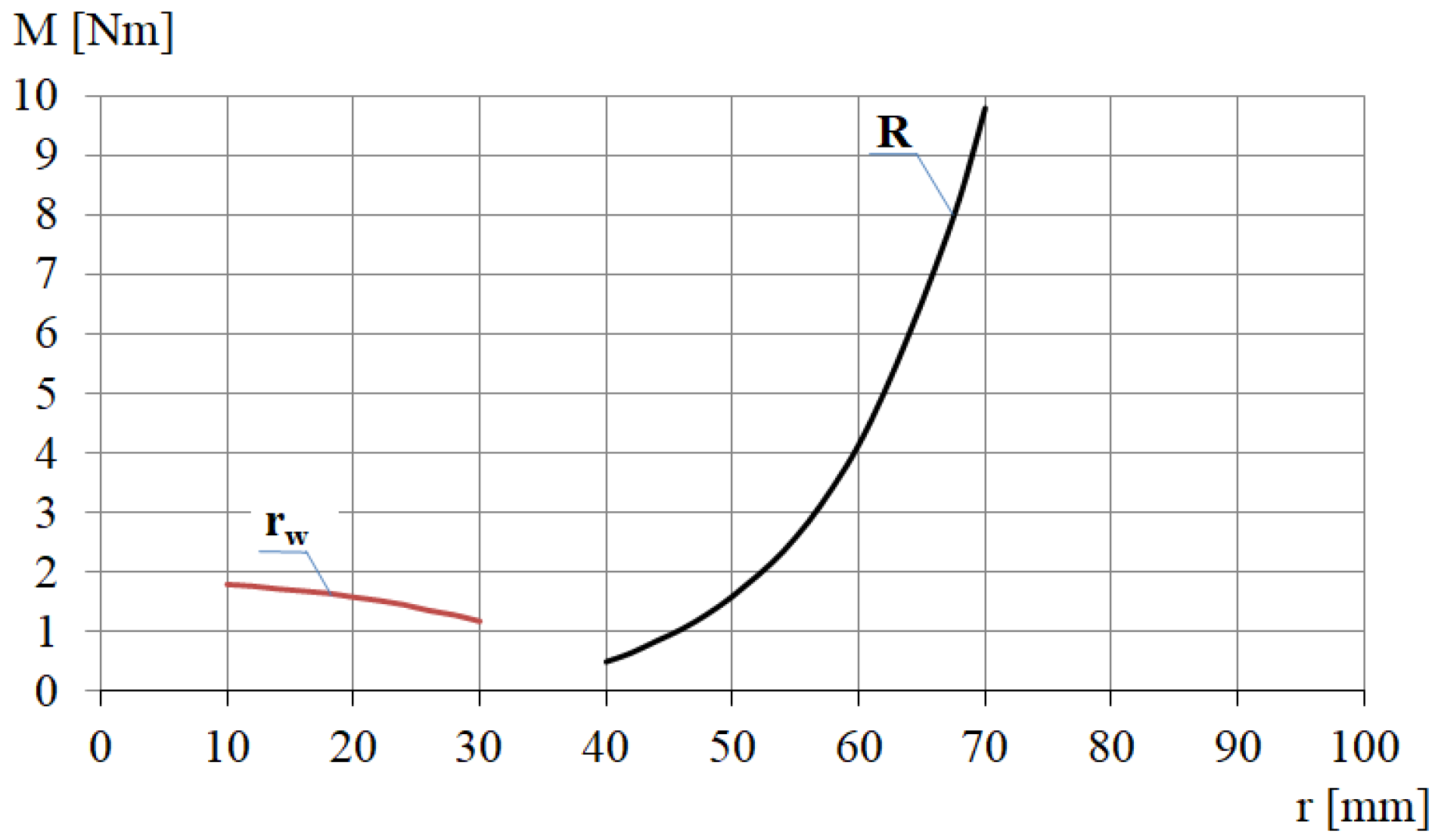
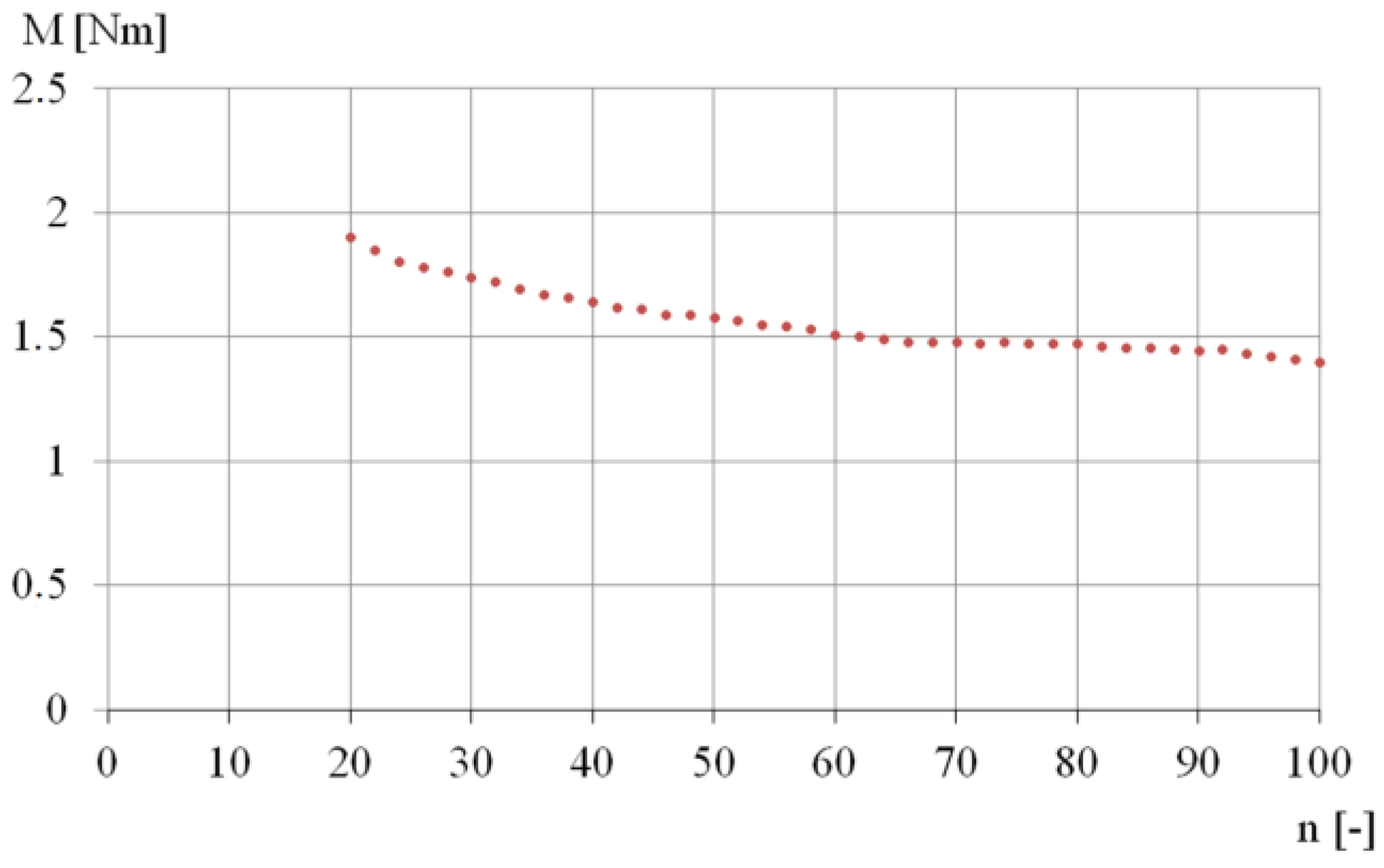
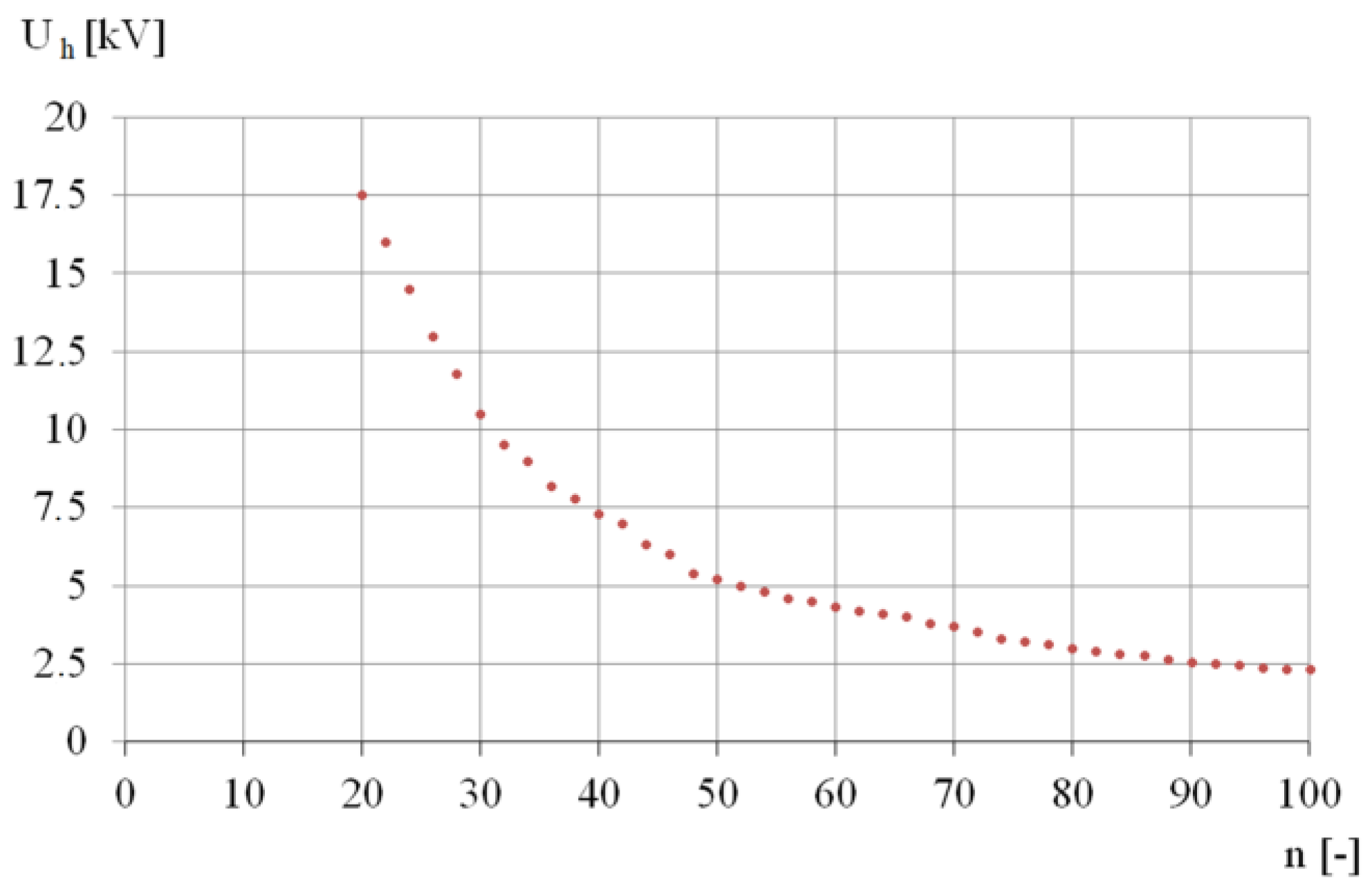
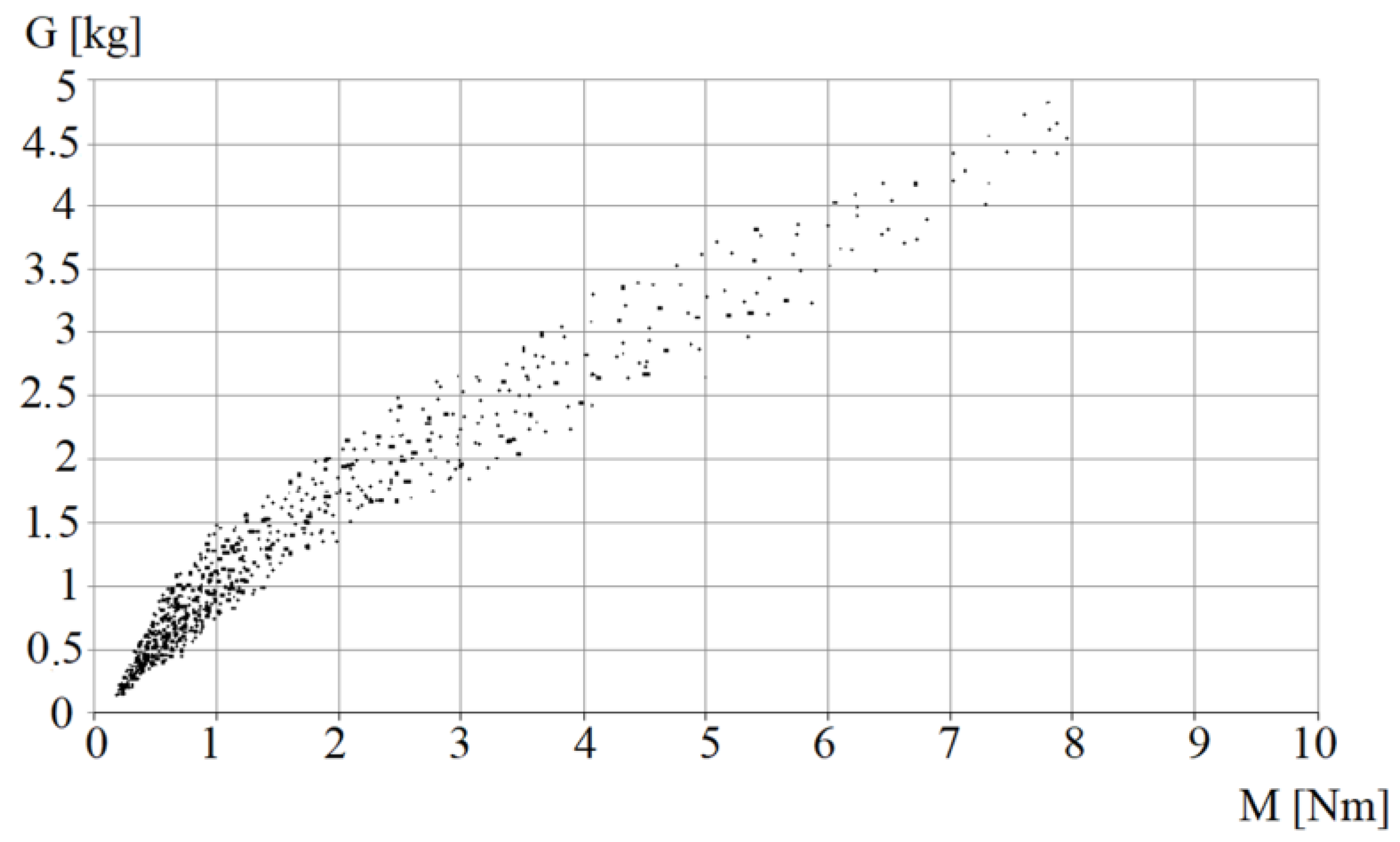

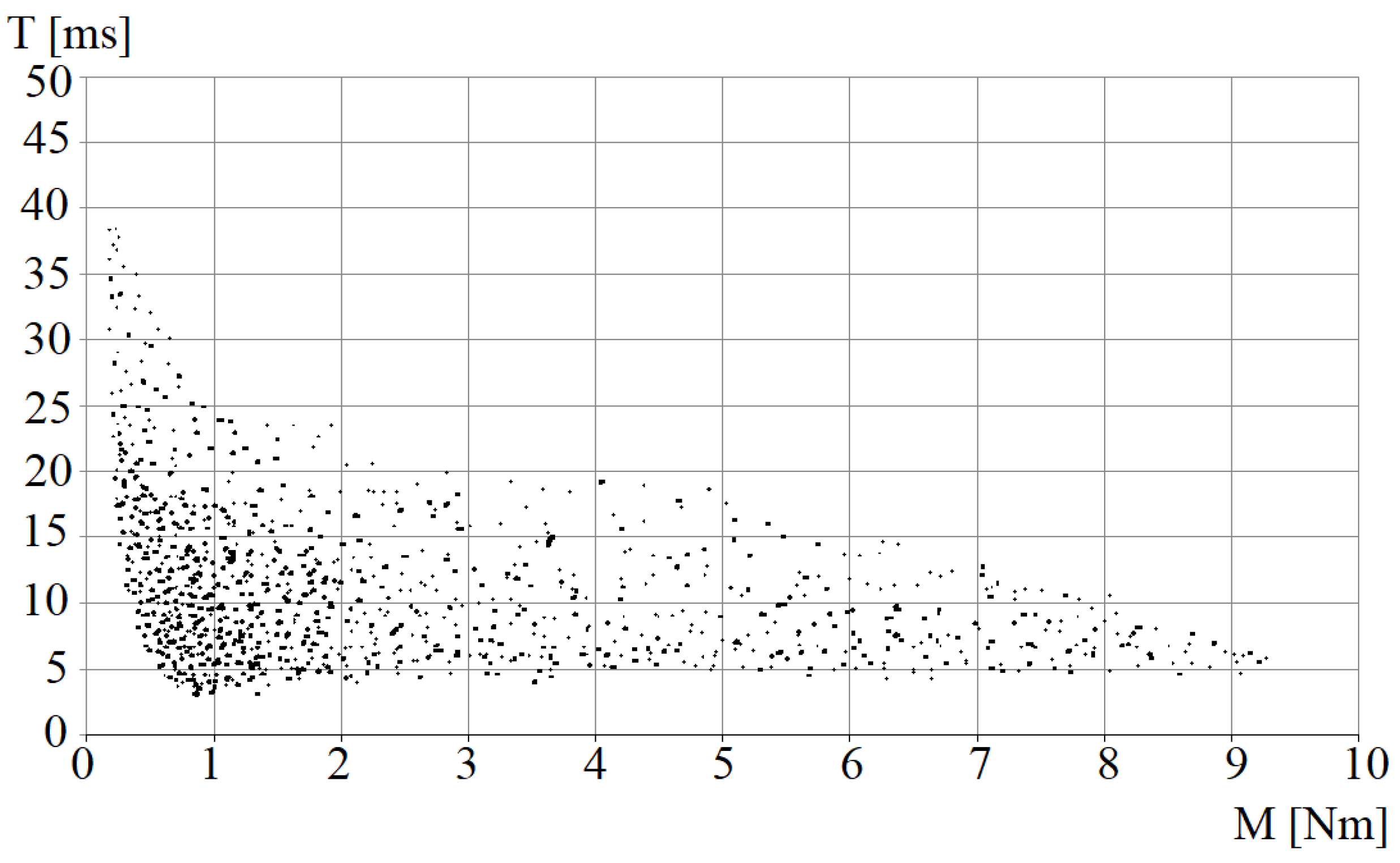
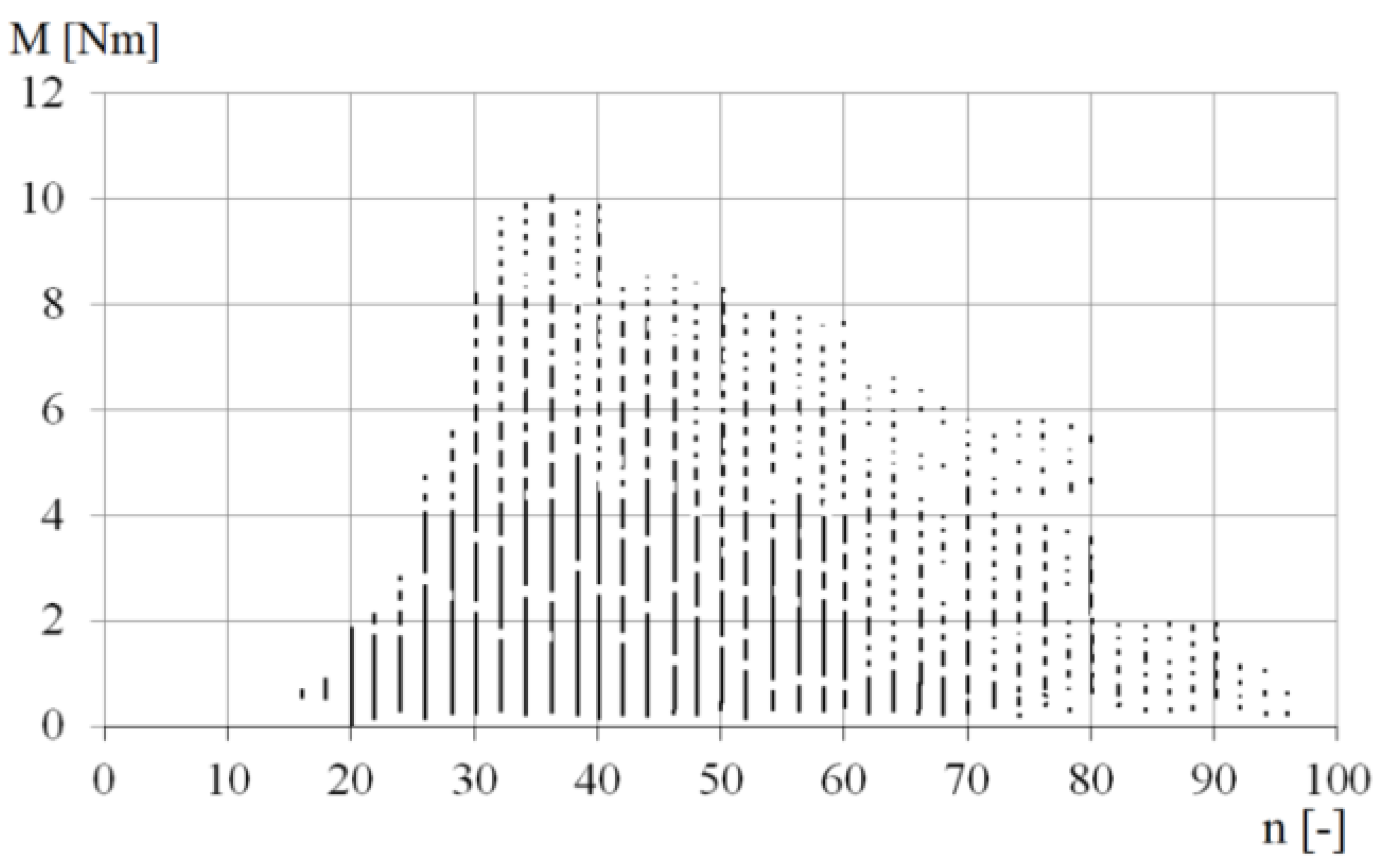
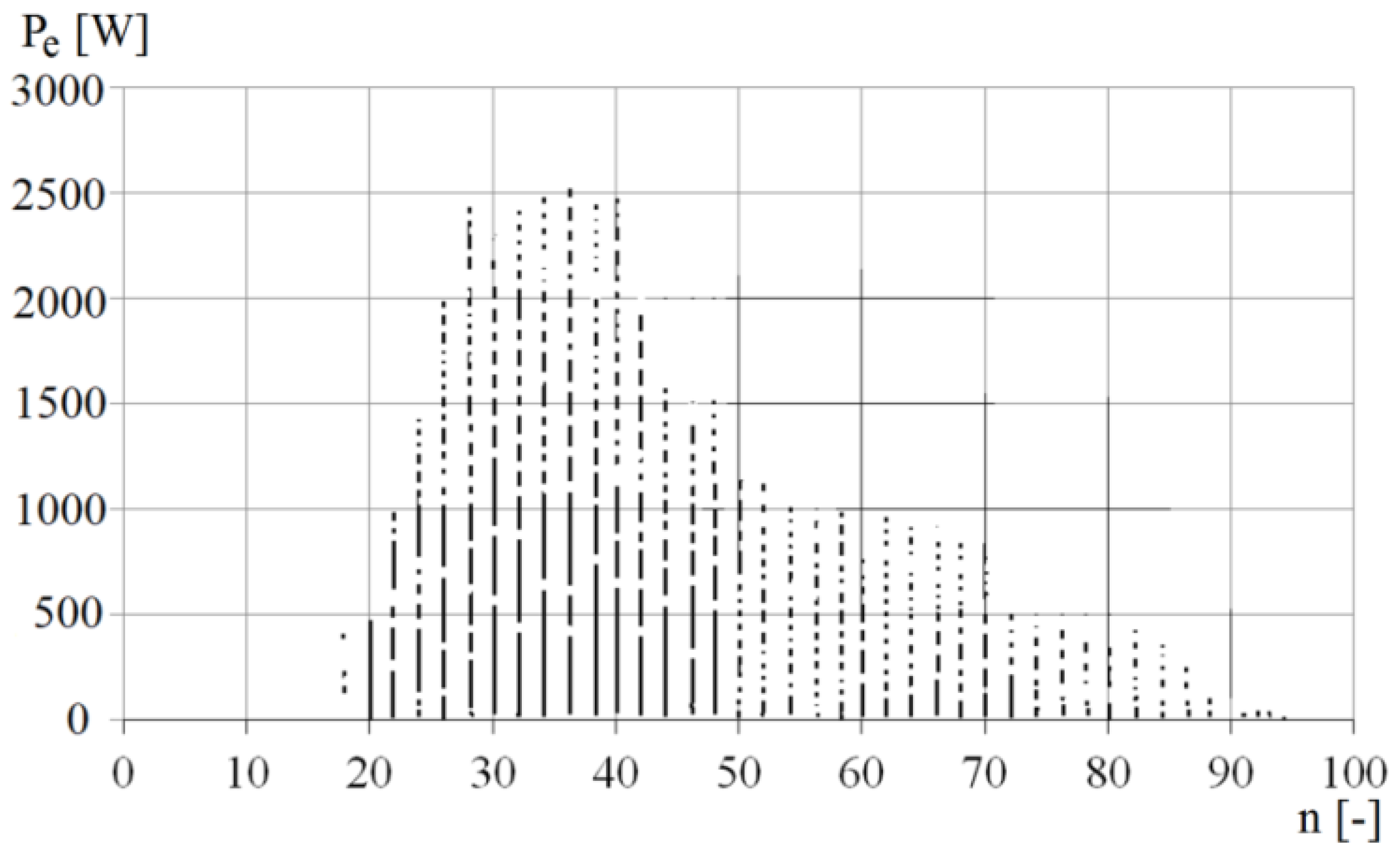


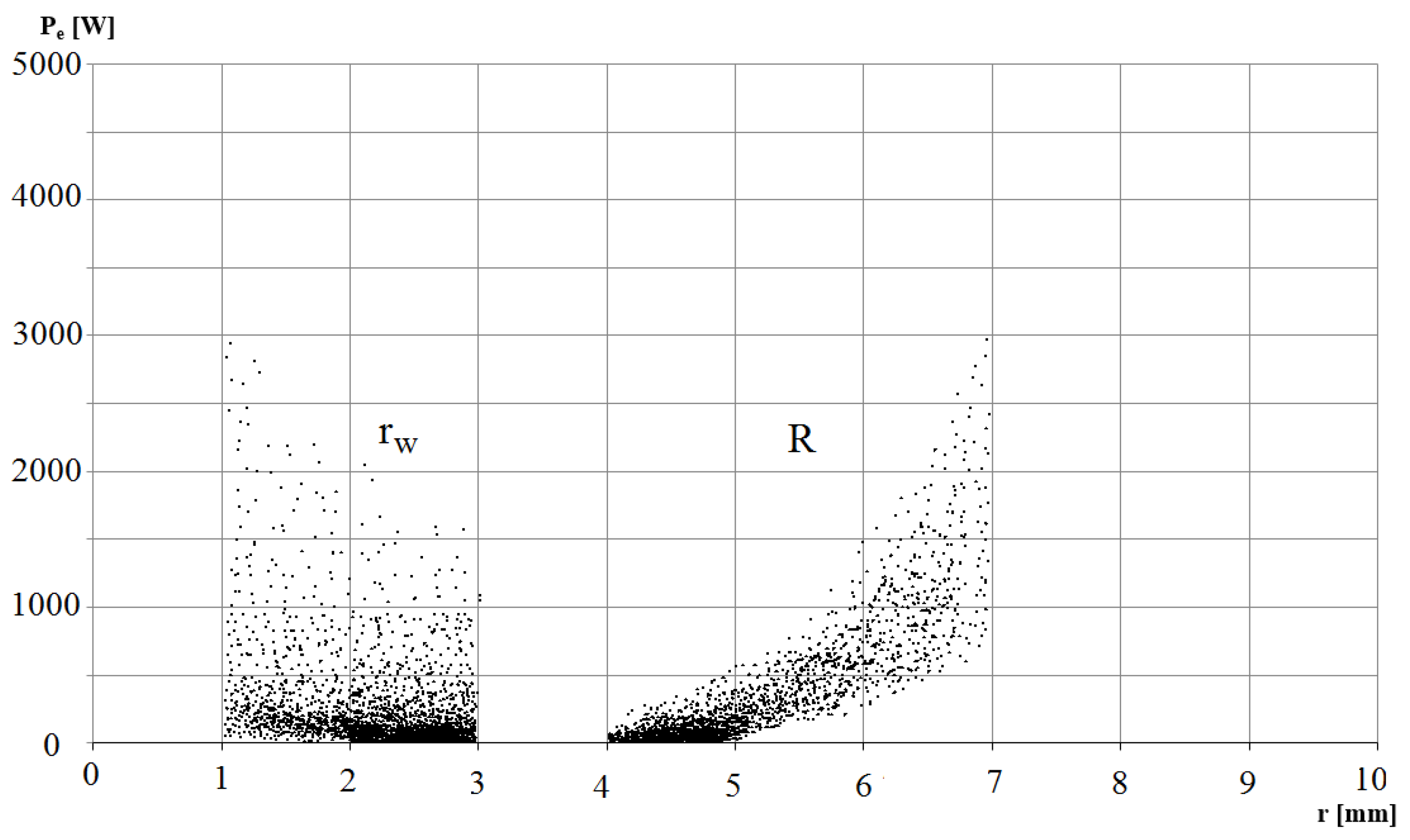

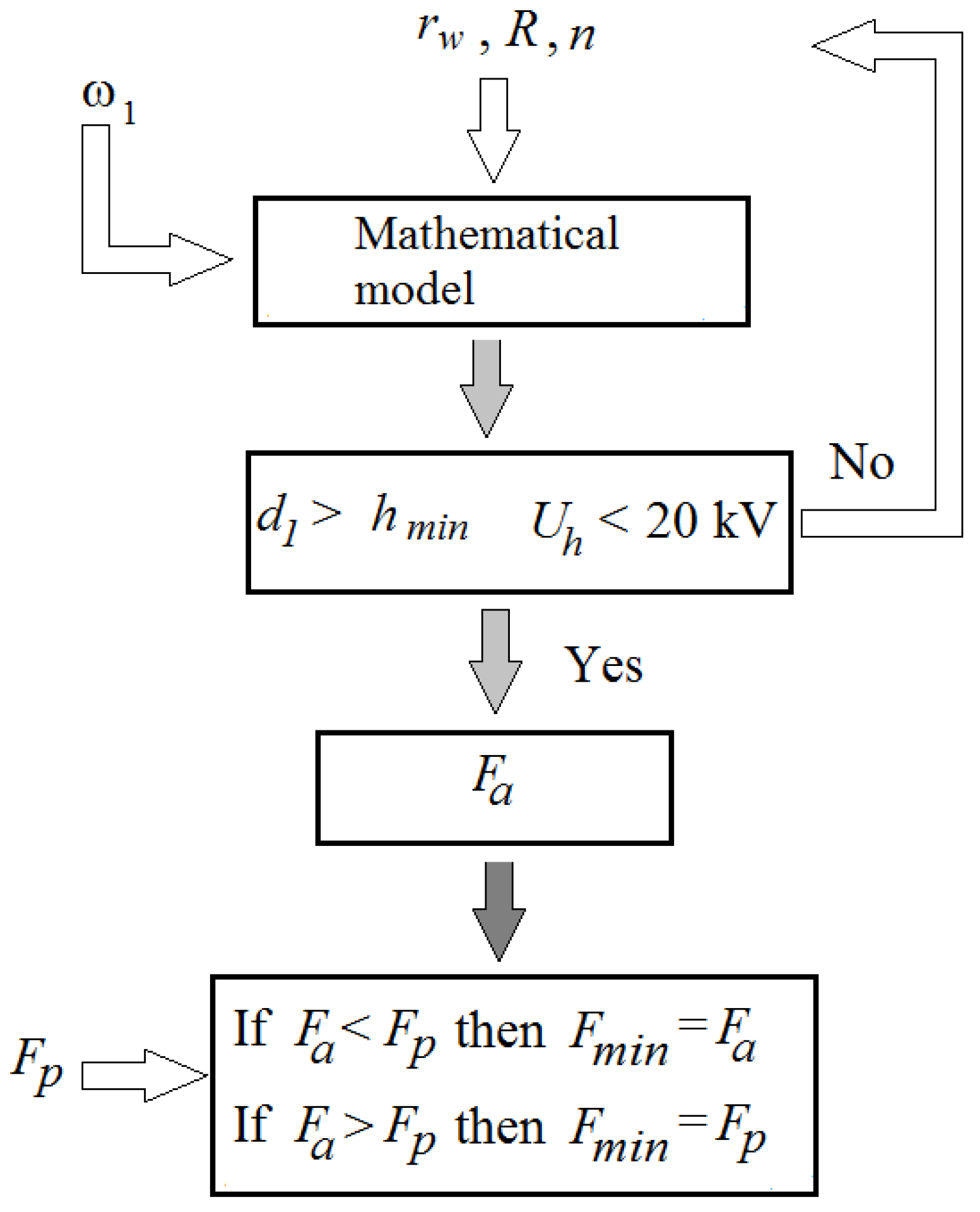

| R mm | rw mm | d1 mm | d2 mm | gb mm | n - | rs mm | r1 mm | r2 mm | ER Fluid LID 3354S |
|---|---|---|---|---|---|---|---|---|---|
| 50.5 | 15.5 | 1.5 | 7.3 | 1.0 | 38 | 37.4 | 28.6 | 44.4 |
| Coefficient | α - | ξ - | c - | a kPa mm2/kV2 | b μA mm2/(cm2 kV2) | β - | εr - |
|---|---|---|---|---|---|---|---|
| Value Formula | 2.30 (7) | 6.64 (22) | 3.93 (23) | 0.41 (27) | 35.31 (28) | 3.00 (35) | 5.00 (37) |
| Parameter Interval | Conditions | |||
|---|---|---|---|---|
| rw mm | R mm | n - | d1 mm | Uh kV |
| 10 < rw< 30 | 40 < R < 70 | 10 < n < 120 | d1 > hmin = 1 | Uh < 20 kV |
| Name | Designation | Requirements | Main Calculation Formula Numbers |
|---|---|---|---|
| Torque | M | Maximal | (16), (17), (25), (26) |
| Weight | G | Minimal | (4)–(7) |
| Electric power | Pe | Minimal | (30), (31), (33), (34) |
| Time | T | Minimal | (35)–(37) |
| Fmin | M Nm | rw mm | R mm | n - | G/M kg/Nm | Pe/M W/Nm | T/M ms/Nm | G kg | Pe W | T ms |
|---|---|---|---|---|---|---|---|---|---|---|
| FGmin | 7.478 | 29.1 | 69.9 | 42 | 0.497 | 181.4 | 0.790 | 3.717 | 1356 | 5.9 |
| FG1min | 7.473 | 29.9 | 69.4 | 38 | 0.446 | 231.6 | 0.681 | 3.333 | 1731 | 5.1 |
| FPmin | 0.218 | 28.8 | 40.9 | 98 | 1.136 | 38.5 | 201.821 | 0.248 | 8.42 | 44.4 |
| FP1min | 0.222 | 28.9 | 41.1 | 100 | 1.150 | 38.2 | 206.113 | 0.255 | 8.45 | 45.8 |
| FTmin | 9.850 | 11.6 | 69.8 | 30 | 0.601 | 254.6 | 0.358 | 5.920 | 2508 | 3.5 |
| FT1min | 9.886 | 10.6 | 69.9 | 30 | 0.611 | 313.3 | 0.489 | 6.040 | 3096 | 4.8 |
| M Nm | rw mm | R mm | n - | G/M kg/Nm | Pe/M W/Nm | T/M ms/Nm | G kg | Pe W | T ms |
|---|---|---|---|---|---|---|---|---|---|
| 1.733 | 15.5 | 50.5 | 38 | 1.013 | 97.9 | 5.72 | 1.756 | 170 | 9.9 |
| Fmin | M Nm | rw mm | R mm | n - | G/M kg/Nm | Pe/M W/Nm | T/M ms/Nm | G kg | Pe W | T ms |
|---|---|---|---|---|---|---|---|---|---|---|
| FGmin | 1.728 | 29.7 | 53.6 | 30 | 0.570 | 239.0 | 3.027 | 0.985 | 413 | 5.2 |
| FG1min | 1.782 | 28.9 | 53.6 | 30 | 0.586 | 240.9 | 3.070 | 1.044 | 429 | 5.4 |
| FPmin | 1.749 | 29.6 | 55.8 | 88 | 0.837 | 64.8 | 14.603 | 1.464 | 113 | 25.5 |
| FP1min | 1.753 | 29.6 | 55.9 | 86 | 0.823 | 66.5 | 13.986 | 1.443 | 116 | 24.5 |
| FTmin | 1.746 | 16.2 | 50.0 | 22 | 0.894 | 356.1 | 2.245 | 1.561 | 621 | 3.9 |
| FT1min | 1.795 | 12.6 | 49.8 | 22 | 0.992 | 351.0 | 2.269 | 1.781 | 630 | 4.0 |
Disclaimer/Publisher’s Note: The statements, opinions and data contained in all publications are solely those of the individual author(s) and contributor(s) and not of MDPI and/or the editor(s). MDPI and/or the editor(s) disclaim responsibility for any injury to people or property resulting from any ideas, methods, instructions or products referred to in the content. |
© 2023 by the authors. Licensee MDPI, Basel, Switzerland. This article is an open access article distributed under the terms and conditions of the Creative Commons Attribution (CC BY) license (https://creativecommons.org/licenses/by/4.0/).
Share and Cite
Kęsy, Z.; Musiałek, I.; Choi, S.-B. Design Optimization of a Hydrodynamic Brake with an Electrorheological Fluid. Appl. Sci. 2023, 13, 1089. https://doi.org/10.3390/app13021089
Kęsy Z, Musiałek I, Choi S-B. Design Optimization of a Hydrodynamic Brake with an Electrorheological Fluid. Applied Sciences. 2023; 13(2):1089. https://doi.org/10.3390/app13021089
Chicago/Turabian StyleKęsy, Zbigniew, Ireneusz Musiałek, and Seung-Bok Choi. 2023. "Design Optimization of a Hydrodynamic Brake with an Electrorheological Fluid" Applied Sciences 13, no. 2: 1089. https://doi.org/10.3390/app13021089






